Page is loading ...

File Management in
OpenOffice.org
Title: File Management in OpenOffice.org
Version: 1.0
First edition: December 2004
First English
edition: December 2004


Contents
Overview........................................................................................................................................ iii
Copyright and trademark information........................................................................................iii
Feedback.................................................................................................................................... iii
Acknowledgments......................................................................................................................iii
Modifications and updates......................................................................................................... iii
Opening files....................................................................................................................................1
File formats................................................................................................................................. 2
Default file format.......................................................................................................................2
Opening text format files.............................................................................................................3
Opening spreadsheets..................................................................................................................3
Opening presentations................................................................................................................. 4
Opening graphic files.................................................................................................................. 4
Opening formula files..................................................................................................................4
Saving files.......................................................................................................................................4
Password protection.................................................................................................................... 5
Saving a document automatically................................................................................................6
Writer can save to these file formats...........................................................................................7
Calc can save to these file formats.............................................................................................. 7
Impress can save to these file formats.........................................................................................8
Draw can save to these file formats.............................................................................................8
The HTML writer can save in these formats...............................................................................8
AportisDoc and PocketWord files for transport to your PDA.................................................... 8
Exporting files..................................................................................................................................9
XHTML Export...........................................................................................................................9
Export to PDF............................................................................................................................. 9
PDF Options................................................................................................................................9
Deleting and renaming files........................................................................................................... 10
Deleting a file............................................................................................................................11
File associations............................................................................................................................. 11
File Management in OpenOffice.org i

Creating new files.......................................................................................................................... 12
Using the Open and Save As dialogs............................................................................................. 13
File Management in OpenOffice.org ii

Overview
Overview
This chapter describes basic file management (opening, saving, exporting, deleting, and
renaming files; creating new files; file associations; and using the OpenOffice.org dialogs) in
all components of OpenOffice.org 1.1.x.
Copyright and trademark information
The contents of this Documentation are subject to the Public Documentation License,
Version 1.0 (the "License"); you may only use this Documentation if you comply with the
terms of this License. A copy of the License is available at:
http://www.openoffice.org/licenses/PDL.rtf.
The Original Documentation is File Management in OpenOffice.org. The Initial Writer(s) of
the Original Documentation is/are Linda Worthington © 2004. All Rights Reserved. (Initial
Writer contact(s): [email protected]. The Initial Writer contact(s) is to report errors in
the documentation. For questions regarding how to use the software, subscribe to the Users
Mail List and post your question there: http://support.openoffice.org/index.html.)
Contributor(s): Ian Laurenson.
Portions created by Ian Laurenson are Copyright © 2004. All Rights Reserved. (Contributor
contact(s): [email protected]).
All trademarks within this guide belong to their legitimate owners.
Feedback
Please direct any comments or suggestions about this document to:
[email protected]e.org.
Acknowledgments
Thanks to Jean Hollis Weber for expanding and revising this document.
Modifications and updates
Version Date Description of Change
1.0 18 December 2004 First published edition.
File Management in OpenOffice.org iii


Opening files
Opening files
To open an existing document, choose File > Open or click the Open File icon on the
Function Toolbar, or press Control+O.
The Open dialog appears. Figure 1 shows the WindowsXP version of this dialog.
Figure 1. Open dialog in WindowsXP
Choose the file to open, then click the Open button.
Note: Under Microsoft Windows there is the option of using either the OpenOffice.org Open and
Save As dialogs or the ones provided by Microsoft Windows. See “Using the Open and Save As
dialogs” on page 13.
File Management in OpenOffice.org 1

Opening files
File formats
OpenOffice.org can import Microsoft Office files. However, Microsoft Office cannot import
OpenOffice.org files, so if you want to send a file to a Microsoft Office user, you must save it
in a Microsoft Office format or in .rtf. Below is a chart for quick reference.
Document
type
Application Document
Extension
Template
Extension
Microsoft
Office eqv
Text Writer .sxw .stw .doc .dot
Spreadsheet Calc .sxc .stc .xls .xlt
Drawing Draw .sxd .std na
Presentation Impress .sxi .sti .ppt .pot .pps
Formula Math .sxm na
Master document Writer .sxg na
HTML document Writer .html na
Default file format
OpenOffice.org saves files in its native format unless you tell it to save them differently. If
you always need to produce files in some other format (such as Microsoft Office formats),
you may wish to change the default file format.
To set the default file format when saving new files:
1) Tools > Options... > Load/Save > General. (See Figure 2.)
2) In the Standard File Format section of this page, choose a document type (for example,
“Text document”) and then choose a file format from the Always Save As list.
3) Repeat for each document type as necessary.
4) Click OK to save your changes.
Note: If the default is set to an OpenOffice.org format and a Microsoft Office file is being saved,
then a warning dialog will be displayed about potential loss of formatting.
File Management in OpenOffice.org 2

Opening files
Figure 2. Choosing default formats for saving files
Opening text format files
In addition to its native formats (.sxw and .stw), OpenOffice.org Writer can import Microsoft
Office formats (.doc, .dot) as well as the .rtf, .txt, .csv and StarWriter formats.
When opening .HTM or .HTML files, OpenOffice.org customizes Writer for working with
these files.
Opening spreadsheets
In addition to the native formats (.sxc and .stc), OpenOffice.org can open the following
spreadsheet formats:
Microsoft Excel 97/2000/XP (*.xls; *.xlw) Rich Text Format (*.rtf)
Microsoft Excel 97/2000/XP Template (*.xlt) Text CSV (*.csv; *.txt)
Microsoft Excel 95 (*.xls; *.xlw) Lotus 123 (*.wk1; *.wk1)
Data Interchange Format (*.def) StarCalc formats
dBase (*.dbf) Sylk
HTM and HTML files including Web page queries
File Management in OpenOffice.org 3

Opening files
Opening presentations
In addition to its native formats (.sxi and .sti), OpenOffice.org can open the following
presentation formats:
Microsoft PowerPoint 97/2000/XP (*.ppt; *.pps)
Microsoft PowerPoint 97/2000/XP Template (.pot)
StarDraw, StarImpress
CGM - Computer Graphics Metafile (*.cgm)
Opening graphic files
In addition to the native formats (.sxd and .std), OpenOffice.org can open the following
graphic formats:
BMP JPEG PGM RAS TGA
DXF MET PLT SGF TIFF
EMF PBM PNG SGV WMF
EPS PCD PPM StarDraw XBM
GIF PCX PSD SVM XPM
Opening formula files
In addition to its native format, OpenOffice.org can open the following formula files:
StarMath and MathML (*.mml).
When opening a Word document that contains an embedded equation editor object, if the
option for it is checked in Tools > Options > Load/Save > Microsoft Office then the object
will be automatically converted to an OpenOffice.org Math object.
Saving files
To save a new file:
1) Choose File > Save As.
2) When the Save As dialog (Figure 3) appears, enter the file name and verify the file
type (if applicable).
Note: File names should never have spaces. If you need to separate the file name, use an
underscore (_) between words; for example, file_maint.sxw.
To save an open document, with no need to change the file name, choose File > Save. This
will overwrite the last saved state of the file.
File Management in OpenOffice.org 4

Saving files
Figure 3. Saving a new file
Password protection
To protect an entire document from being viewable without a password, there is an option on
the Save As dialog to enter a password. This option is only available for files saved in
OpenOffice.org formats.
1) On the Save As dialog (Figure 3), mark the checkbox beside Save with password, and
then click Save. You will receive a prompt:
2) Enter the same password in the Password field and the Confirm field, and then click
OK.
File Management in OpenOffice.org 5

Saving files
If the passwords match. the document will be saved password protected. If the
passwords do not match, you will receive the prompt to enter the password again.
Note: Passwords must contain a minimum of 5 characters. Until you have entered 5 characters,
the OK button remains inactive.
Saving a document automatically
You can choose to have OpenOffice.org save files for you automatically. Automatic saving,
like manual saving, will overwrite the last saved state of the file. To set up automatic file
saving:
1) Choose Tools > Options > Load/Save > General. (See Figure 4.)
2) Mark Autosave every, set the time interval. If you want to be prompted before the file
is automatically saved, select the Prompt to save checkbox as well.
Figure 4. Choosing to save a document automatically
File Management in OpenOffice.org 6

Saving files
Writer can save to these file formats
In addition to its native formats (.sxw and .stw), Writer can save in these formats:
OpenOffice.org Writer template (.stw)
Microsoft Word 97/2000/XP (.doc)
Microsoft Word 95 (.doc)
Microsoft Word 6.0 (.doc)
Rich Text Format (.rtf)
StarWriter 5.0 (.sdw)
StarWriter Template (.vor)
StarWriter 4.0 (.sdw)
StarWriter 4.0 Template (.vor)
StarWriter 3.0 (.sdw)
StarWriter Template 3.0 (.vor)
Text (.txt)
Text Encoded (.txt)
HTML (.html; .htm)
Note: The .rtf format is a common format for transferring text files between applications but be
aware of the lack of formating available in that format. It also seems that there is a bug
concerning files saved in the .rtf format that contain images when opened by Microsoft Office.
So the best way to pass a file in writer to a Microsoft Word user is to save it as Microsoft Word
97/2000/XP (.doc).
Calc can save to these file formats
In addition to its native formats (.sxc and stc), Calc can save in these formats:
Microsoft Excel 97/2000/XP (*.xls; *.xlw)
Microsoft Excel 97/2000/XP Template (*.xlt)
Microsoft Excel 95 (*.xls; *.xlw)
Data Interchange Format (*.dif)
dBase (*.dbf)
SYLK (*.slk)
Text CSV (*.csv; *.txt)
StarCalc formats (*.sdc, *.vor)
HTM and HTML files
File Management in OpenOffice.org 7

Saving files
Impress can save to these file formats
Microsoft PowerPoint 97/2000/XP (*.ppt; *.pps)
Microsoft PowerPoint 97/2000/XP Template (*.pot)
StarDraw, StarImpress (*.sda, *.sdd, *.vor)
Impress can also export to MacroMedia Flash (*.swf) and any of the graphics formats as
listed below for Draw.
Draw can save to these file formats
Draw can only save in its native formats (.sxd and .std) and StarDraw format, but can export
to BMP, EMF, EPS, GIF, JPEG, MET, PBM, PCT, PGM, PNG, PPM, RAS, SVG, SVM,
TIFF, WMF, and XPM.
The HTML writer can save in these formats
HTML Document (*.html; *.htm)
OpenOffice.org 1.0 HTML Template (*.stw)
StarWriter/Web5.0 and 4.0 (*.vor)
Text (OpenOffice.org Writer/Web) (*.txt)
Text Encoded (OpenOffice.org Writer/Web) (*.txt)
AportisDoc and PocketWord files for transport to
your PDA
When installing OpenOffice.org, you can optionally choose to install filters for saving and
opening documents in formats suitable for mobile devices compatible with Palm OS and
PocketPC (AportisDoc, PocketWord and PocketExcel). These filters are not installed by
default.
To add the filters later:
1) Go to the folder in which OpenOffice.org is installed and start Setup.exe.
2) On the Installation program for OpenOffice.org page of the Setup Wizard, choose
Modify and click Next.
3) On the Select OpenOffice.org Modules page, click the plus sign next to Optional
Components, then click the plus sign next to Mobile Device Filters at the bottom of
the list.
4) Click on the components you want to install, then click the Modify button at the
bottom of the page. The filters will be installed.
Once the filters are installed, the formats are then added to the Save As menu automatically.
Note: The Java Runtime Environment is required to use the mobile device filters.
File Management in OpenOffice.org 8

Exporting files
Exporting files
XHTML Export
OpenOffice.org has the ability to export files to XHTML. This feature is not installed by
default. You can either choose this filter on first install or add it later using the procedure
described above for AportisDoc and PocketWord filters. On the Select OpenOffice.org
Modules page of the Setup Wizard, click the plus sign next to Optional Components and
select XSLT Sample Filters. This will install the XHTML export filter.
Export to PDF
In each application there is the ability to directly export to PDF. This industry-standard file
format for file viewing is ideal for sending the file to someone else to view using Acrobat
Reader.
You can export directly to PDF using a button on the toolbar or by choosing File >
Export.
If you use File > Export, you are asked to enter the filename for the PDF file and then the
PDF Options dialog (Figure 5) opens.
Figure 5. Specifying the PDF export options
Note: If you use the Export Directly as PDF button, you are asked to enter the filename for the
PDF file, but you do not get a chance to choose a page range or the print quality.
PDF Options
All
Exports the entire document.
Range
To export a range of pages, use the format 3-6. To export single pages, use the format 7;9;11.
If you want, you can export a combination of page ranges and single pages, by using the
format 3-6;8;10;12.
File Management in OpenOffice.org 9

Exporting files
Screen optimized
Files will be very small but they will not print well.
Print optimized
Files are optimized for high quality printing and the file sizes will be somewhat larger than
the Screen optimized files.
Press optimized
Files are optimized for the highest quality and are the largest file sizes.
See Table 1 for a summary of compression options.
Table 1. Comparison of PDF optimization options
Screen
optimized
Print optimized Press optimized
Resolution 600dpi 1200dpi 2400dpi
Compress Text and
Line Art
yes yes yes
Bitmap Images
Resampling Average
Downsampling at
72dpi
Bicubic Downsampling at
300dpi
Bicubic Downsampling
at 300dpi
Compression Automatic Automatic Automatic
Quality Medium High Maximum
Monochrome Bitmap Images
Resampling Average
Downsampling at
300dpi
Bicubic Downsampling at
1200dpi
Bicubic Downsampling
at 1200dpi
Compression CCITT Group 4 CCITT Group 4 CCITT Group 4
Deleting and renaming files
You can rename or delete files within the OpenOffice.org dialogs. It is not possible to copy
and paste files within the dialogs.
To rename a file while using OpenOffice.org:
1) Choose File > Open and browse to the required file.
2) Right-click on the file name and choose Rename. The file name will be selected.
3) Typing replaces the selected name, or use a left or right arrow key to move the
insertion point to modify the existing name.
File Management in OpenOffice.org 10

Deleting and renaming files
Deleting a file
To delete a file while using this dialog:
1) Right-click on the file name to display a context menu.
2) Click Delete and you will get a confirmation dialog. Note: Instead of Right-click >
Delete, you can simply press the Delete key.
File associations
File associations are used to open certain types of files automatically with OpenOffice.org.
You have the option to associate Microsoft Office files with OpenOffice. When installing
OpenOffice.org you are prompted to associate file types, as shown in Figure 6.
File Management in OpenOffice.org 11

File associations
Figure 6. Choosing file associations when installing OpenOffice.org
If during installation you chose not to have OpenOffice.org automatically open Microsoft
Word files, you can change this later by modifying the installation. To do this:
1) Go to the folder in which OpenOffice.org is installed and start Setup.exe.
2) On the Installation program for OpenOffice.org page of the Setup Wizard, choose
Modify and click Next.
3) Continue through the Setup Wizard until you reach the page shown in Figure 6. Select
the file types you want OOo to open (put a mark in each checkbox) and click OK.
Creating new files
Different ways of creating a new document:
• File > New.
• Use the New button on the Function Bar. This button has the long-click feature for
selecting the type of document to be created.
• From a “Quick start” program. For instance, the Microsoft Windows version of
OpenOffice.org has a Quickstart icon in the system tray.
• Control + N.
• Using AutoPilots: File > AutoPilot.
File Management in OpenOffice.org 12

Using the Open and Save As dialogs
Using the Open and Save As dialogs
Under Microsoft Windows there you can choose whether to use the OpenOffice.org Open
and Save As dialogs or the ones provided by Microsoft Windows. To view or change which
type of dialog OpenOffice.org is using:
1) Choose Tools > Options... > OpenOffice.org > General.
2) Select the Use OpenOffice.org dialogs checkbox.
This section discusses the OpenOffice.org Open and Save As dialogs.
Figure 7. The OOo Open dialog, showing some of the file formats that can be opened
The three buttons in the top right of the OOo Open dialog are, from left to right:
• Go up one level in the folder (directory) hierarchy. Note that this is a long-click button
if you want to go up higher than just one level.
• New folder.
• Default Directory.
For OpenOffice.org documents that have been saved with more than one version, use the
version drop-down to select which version you wish to open in read-only mode.
Note: For Microsoft Office documents, only the current version can be opened.
File Management in OpenOffice.org 13

Using the Open and Save As dialogs
Use the File type field to specify the type of file to be opened or the format of the file to be
saved.
The Read only checkbox opens the file for reading and printing only. Consequently most of
the toolbars disappear and most menu options are disabled. An Edit File button is displayed
on the Function Toolbar to open the file for editing.
It is possible to open files from the web using URLs.
Figure 8. The OpenOffice.org Save As dialog, showing some of the Save formats
File Management in OpenOffice.org 14
/
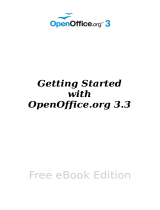
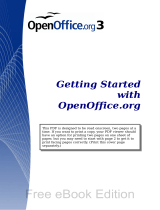
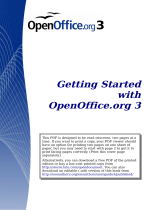

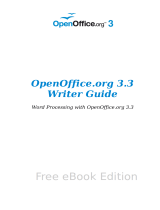


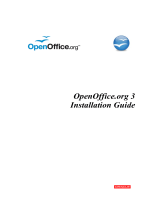


![SuseLinux Professional 9.2 Upgrade [Strong Encryption 128 Bit]](http://vs1.manuzoid.com/store/data/000336272_2-8918b86fe5596dedffb3db1221048e46-160x210.png)
